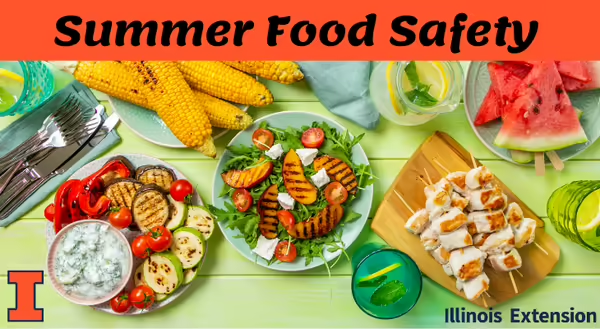
Summer is officially here! If you haven’t already gotten your grill out, you should consider doing so.
Grilling is a great way to keep the kitchen cool and enjoy many of your favorite summer foods. Whether you are grilling meat, poultry, seafood, or vegetables, it is important to food safety at the forefront. Perhaps you haven’t thought much about food safety lately. However, during our warm summer months, there is an increase in the number of foodborne-related illnesses.
Following these simple food safety guidelines can help prevent foodborne related illnesses caused by the overgrowth of harmful bacteria.
Thaw Foods Safely
Keep meat, poultry, and seafood cool until you are ready to use it. This is an important factor because the harmful bacteria responsible for foodborne-related illnesses grow amazingly quickly at room temperature. Thus leaving items out in sinks and on countertops provides the bacteria the opportunity to multiply and reach dangerous levels.
And it is even more important to keep these items cool in warmer weather. If the temperature is 90˚F or higher, the time needed for these harmful bacteria to reach unsafe levels can be as little as one hour.
Therefore, when thawing, you will need to plan ahead. Thaw items in the refrigerator; depending upon the size of the items, things should thaw in 12-24 hrs.
When thawing, place items on a plate or shallow tray and put them on the lowest shelf in the refrigerator. This will help reduce the risk of contaminating other things and catch any juices that may leak and drip onto other items in the fridge.
If you thaw these items in the microwave, it is essential to cook them immediately after thawing. Due to the nature of microwaves, they heat unevenly. Thus some areas of the food may begin to cook during the thawing process, while other areas are simply warmed. Therefore, with the uneven heating, food may have reached optimal temperatures in which bacteria can grow and multiply quickly.
Marinating Foods
A marinade is a savory, usually acidic sauce in which meat, poultry, seafood, or a vegetable are soaked to either enrich its flavor or tenderize it. When marinating, always keep these foods refrigerated to prevent the risk of foodborne-related illness.
How long can you marinate?
- For beef, pork, lamb, and veal; chops, roasts, and steaks can marinate for up to five days
- For poultry or cured meats; items can be marinated for up to two days
Warning: Do not reuse marinade sauces on cooked foods once they have been in contact with raw meat or poultry. Instead, set a portion of the marinade aside to be used later on cooked foods. If you wish to reuse marinade sauces that have been in contact with raw meat or poultry, you must first bring it to a full boil to destroy any harmful bacteria before it can be reused.
Safe Cooking Temperatures
Believe it or not, color is not an indicator of doneness in meat and poultry. This is because the meat may turn brown before it reaches a high enough temperature to destroy the harmful bacterial responsible for foodborne-related illnesses. Always use a food thermometer to check for doneness, to ensure foods are cook to safe temperatures.
- Meat: Cook beef, pork, veal, and lamb roasts, steaks, and chops to a minimum internal temperature of least 145° F (63° C), with a 3 minute rest time.
- Ground Meat: Cook ground beef, veal, lamb, and pork to a minimum internal temperature of at least 160° F (71° C).
- Poultry: Cook all poultry to a minimum safe internal temperature of 165° F (74° C). Consumers may wish to cook poultry to a higher temperature for personal preference.
- Warning: Never partially grill meat or poultry with the plan to finish cooking later as it creates an ideal environment for the growth of harmful bacterial.
Summer is a great time to be outdoors. And grilling is a quick and easy way to cook your favorite summertime foods without heating the kitchen. Remember to follow these basic food safety guidelines to help you and your loved ones stay safe during the summer grilling season.
MEET THE AUTHOR: Diane Reinhold, MPH, MS, RDN is a University of Illinois Extension, Educator, Nutrition and Wellness, serving Jo Daviess, Stephenson & Winnebago Counties
References:
Assistant Secretary for Public Affairs (ASPA). (2021, April 21). Safe Minimum Cooking Temperatures Chart. FoodSafety.gov. https://bit.ly/3jDrjR6
Center for Food Safety and Applied Nutrition. (2017, November 30). Safe Food Handling. U.S. Food and Drug Administration. https://bit.ly/366X50Y
U.S. Food and Drug Administration, Center for Food Safety and Applied Nutrition’s Food and Cosmetic Information Center. (2017, April.). Eating Outdoors: Handling Food Safely. https://www.fda.gov/media/79871/download.